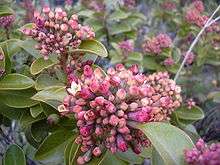Santalales
| Santalales | |
|---|---|
 | |
| Santalum haleakalae | |
| Scientific classification | |
| Kingdom: | Plantae |
| Clade: | Angiosperms |
| Clade: | Eudicots |
| Clade: | Superasterids |
| Order: | Santalales |
| Families | |
|
See text | |
The Santalales are an order of flowering plants with a cosmopolitan distribution, but heavily concentrated in tropical and subtropical regions. It derives its name from its type genus Santalum (sandalwood). Mistletoe is the common name for a number of parasitic plants within the order.
Overview
Many of the members of the order are parasitic plants, mostly hemiparasites, able to produce sugars through photosynthesis, but tapping the stems or roots of other plants to obtain water and minerals; some (e.g. Arceuthobium) are obligate parasites, have low concentrations of chlorophyll within their shoots (1/5 to 1/10 of that found in their host’s foliage), and derive the majority of their sustenance from their hosts' vascular tissues (water, micro- and macronutrients, and sucrose).
Most have seeds without testae (seed coats), which is unusual for flowering plants.
Classification
The APG III system of 2009 (slightly changed from the APG II system of 2003 and the APG system of 1998) uses this circumscription:
- order Santalales
- family Balanophoraceae
- family Loranthaceae
- family Misodendraceae
- family Olacaceae
- family Opiliaceae
- family Santalaceae
- family Schoepfiaceae
The Angiosperm Phylogeny website indicates the Olacaceae (sensu APG II) are not a good family and should be split. Furthermore, it indicates disagreements about Santalaceae which need to include Viscaceae to be monophyletic (as is done in APG III). Studies based on DNA sequences also indicate the family Schoepfiaceae should be resurrected (as has been done in the updated APG III-publication) to accommodate Schoepfia (formerly in Olacaceae), Arjona and Quinchamalium (both previously in Santalaceae).
In the classification system of Dahlgren the Santalales were in the superorder Santaliflorae (also called Santalanae). The Cronquist system (1981) used this circumscription:
- order Santalales
- family Medusandraceae
- family Dipentodontaceae
- family Olacaceae
- family Opiliaceae
- family Santalaceae
- family Misodendraceae
- family Loranthaceae
- family Viscaceae
- family Eremolepidaceae
- family Balanophoraceae
The families Viscaceae and Eremolepidaceae are included in the family Santalaceae by the APG. The genera Dipentodon (Dipentodontaceae) and Medusandra (family Medusandraceae) are regarded as unplaced by APG II (as is the family Balanophoraceae, now likely to be reincluded; see above). The family Medusandraceae consisted of two genera: Soyauxia and Medusandra. Molecular evidence places them within the family Peridiscaceae of the order Saxifragales. The Chinese monotypic genus Dipentodon is close to Tapiscia and is proposed to constitute the new order Huerteales with Tapisciaceae and the genus Perrottetia formerly placed in the family Celastraceae.
References
| Wikimedia Commons has media related to Santalales. |
| Wikispecies has information related to: santalales |
- Hawksworth, FG (1996). Dwarf mistletoes : biology, pathology, and systematics. USDA For. Serv. Agric. Handb. p. 409.
- Soltis, Douglas E.; Soltis, Pamela S.; Endress, Peter K.; Chase, Mark W. (2005-06-15). Phylogeny & Evolution of Angiosperms. Sinauer Associates. p. 370. ISBN 978-0-87893-817-9.
- Santalales on the Parasitic Plant Connection web page
- NCBI Taxonomy Browser